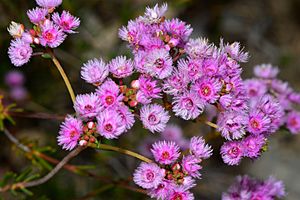Verticordia fimbrilepis subsp. fimbrilepis facts for kids
Quick facts for kids Verticordia fimbrilepis subsp. fimbrilepis |
|
|---|---|
 |
|
| Conservation status | |
| Scientific classification |
|
| Kingdom: | Plantae |
| Clade: | Tracheophytes |
| Clade: | Angiosperms |
| Clade: | Eudicots |
| Clade: | Rosids |
| Order: | Myrtales |
| Family: | Myrtaceae |
| Genus: | Verticordia |
| Species: | |
| Subspecies: |
V. f. subsp. fimbrilepis
|
| Trinomial name | |
| Verticordia fimbrilepis subsp. fimbrilepis |
|
Verticordia fimbrilepis subsp. fimbrilepis is a beautiful flowering plant. It belongs to the myrtle family, called Myrtaceae. This plant is special because it only grows in the south-west part of Western Australia. It is a small, bushy shrub. It has one main stem that branches out. Its leaves are small and pointed. The plant grows pretty pink flowers in round groups. These flowers appear near the ends of its branches.
Contents
What Does This Plant Look Like?
Verticordia fimbrilepis subsp. fimbrilepis is a shrub. It usually grows to be about 30–70 cm (10–30 in) tall and wide. It has one main stem that branches out widely from its base.
Leaves and Flowers
The leaves lower down on the stems are thin and almost round. They are about 2–5 mm (0.08–0.2 in) long. Each leaf has a rounded end with a sharp point. The leaves closer to the flowers are more oval or narrow egg-shaped.
The flowers grow in round groups. They are on small stalks about 2–4 mm (0.08–0.2 in) long. These groups appear near the ends of the branches. The base of the flower, called the floral cup, is shaped like a wide top. It is about 1.5 mm (0.06 in) long. This part is smooth but a little rough.
The sepals are parts that protect the flower bud. They are pale pink to bright pink, or sometimes white. They are about 3–3.5 mm (0.12–0.14 in) long. Each sepal has 5 to 7 hairy parts. The petals are also pink or white. They are about 2.5–3.0 mm (0.098–0.12 in) long and 1.5 mm (0.06 in) wide. They are egg-shaped and have long, rough hairs. The plant blooms from November to December or January.
How This Plant Got Its Name
The plant Verticordia fimbrilepis was first officially described in 1847. This was done by a scientist named Nikolai Turczaninow. He published his description in a science journal. He used plant samples collected by James Drummond.
Later, in 1991, another scientist named Alex George studied the Verticordia group of plants. He decided that V. fimbrilepis had two different types, or subspecies. This plant is one of those types.
Where Does This Plant Grow?
This special verticordia plant grows in low, sandy areas. You can find it in different kinds of plant communities. These include heathlands, shrublands, and wandoo woodlands. It grows in scattered spots around places like Woodanilling, Brookton, and Narrogin. These areas are in the Avon Wheatbelt and Jarrah Forest regions of Western Australia.
Protecting This Special Plant
This type of Verticordia fimbrilepis is considered "Threatened". This classification comes from the Western Australian Government's Department of Parks and Wildlife. It means the plant might become extinct, or it is very rare. It needs special protection to survive.
It is also listed as "Endangered" (EN) under an Australian Government law. This law is called the Environment Protection and Biodiversity Conservation Act 1999 (EPBC Act). Because it is endangered, a plan has been made to help it recover.
Growing This Plant
This subspecies of V. fimbrilepis is a small, open shrub. It has delicate pink flowers. However, it is quite hard to grow. So far, it has only been successfully grown at Kings Park in Western Australia. There is also one plant growing in Sydney.


